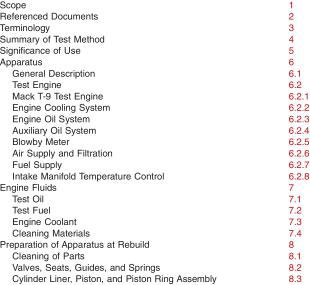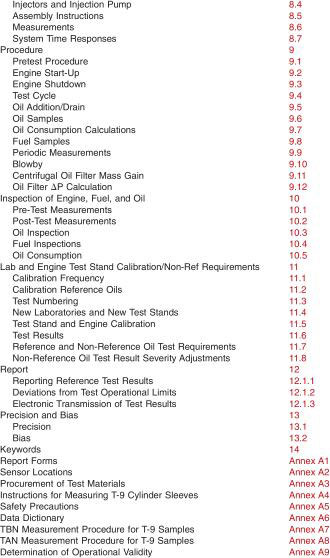1. Scope
1.1 This test method covers an engine test procedure for evaluating diesel engine oils for performance characteristics, including lead corrosion and wear of piston rings and cylinder liners. This test method is commonly referred to as the Mack T-9.
1.2 The values stated in SI units are to be regarded as the standard. The values given in parentheses are for information only.
1.3 This standard does not purport to address all of the safety concerns, if any, associated with its use. It is the responsibility of the user of this standard to establish appropriate safety and health practices and determine the applicability of regulatory limitations prior to use. See Annex A5 for specific safety precautions.
1.4 Table of Contents:


2. Referenced Documents
2.1 ASTM Standards:
D86 Test Method for Distillation of Petroleum Products at Atmospheric Pressure
D93 Test Methods for Flash Point by Pensky-Martens Closed Cup Tester
D97 Test Method for Pour Point of Petroleum Products
D129 Test Method for Sulfur in Petroleum Products (General Bomb Method)
D130 Test Method for Corrosiveness to Copper from Petroleum Products by Copper Strip Test
D235 Specification for Mineral Spirits (Petroleum Spirits) (Hydrocarbon Dry Cleaning Solvent)
D287 Test Method forAPI Gravity of Crude Petroleum and Petroleum Products (Hydrometer Method)
D445 Test Method for Kinematic Viscosity of Transparent and Opaque Liquids (the Calculation of Dynamic Viscosity)
D482 Test Method for Ash from Petroleum Products
D524 Test Method for Ramsbottom Carbon Residue of Petroleum Products
D613 Test Method for Cetane Number of Diesel Fuel Oil
D664 Test Method forAcid Number of Petroleum Products by Potentiometric Titration
D1319 Test Method for Hydrocarbon Types in Liquid Petroleum Products by Fluorescent Indicator Adsorption
D2500 Test Method for Cloud Point of Petroleum Oils
D2622 Test Method for Sulfur in Petroleum Products by Wavelength Dispersive X-ray Fluorescence Spectrometry
D2709 Test Method for Water and Sediment in Middle Distillate Fuels by Centrifuge
D2896 Test Method for Base Number of Petroleum Products by Potentiometric Perchloric Acid Titration
D4052 Test Method for Density and Relative Density of Liquids by Digital Density Meter
D4485 Specification for Performance of Engine Oils
D4737 Test Method for Calculated Cetane Index by Four Variable Equation
D4739 Test Method for Base Number Determination by Potentiometric Titration
D5185 Test Method for Determination of Additive Elements, Wear Metals, and Contaminants in Used Lubricating Oils and Determination of Selected Elements in Base Oils by Inductively Coupled Plasma Atomic Emission Spectrometry (ICP-AES)
D5302 Test Method for Evaluation of Automotive Engine Oils for Inhibition of Deposit Formation and Wear in a Spark-Ignition Internal Combustion Engine Fueled with Gasoline and Operated Under Low-Temperature, Light-Duty Conditions
D5844 Test Method for Evaluation of Automotive Engine Oils for Inhibition of Rusting (Sequence IID)
D5967 Test Method for Evaluation of Diesel Engine Oils in T-8 Diesel Engine
E 29 Practice for Using Significant Digits in Test Data to Determine Conformance with Specifications
E 178 Practice for Dealing With Outlying Observations
E 344 Terminology Relating to Thermometry and Hydromometry
2.2 SAE Standards:
SAE J1995 Engine Power Test Code - Spark Ignition and Compression Ignition - Gross Power Rating
3. Terminology
3.1 Definitions:
3.1.1 blind reference oil, n - a reference oil, the identity of which is unknown by the test facility.
3.1.1.1 Discussion - This is a coded reference oil that is submitted by a source independent from the test facility.
3.1.2 blowby, n - in internal combustion engines, the combustion products and unburned air-and-fuel mixture that enter the crankcase.
3.1.3 calibrate, v - to determine the indication or output of a measuring device with respect to that of a standard.
3.1.4 candidate oil, n - an oil that is intended to have the performance characteristics necessary to satisfy a specification and is intended to be tested against that specification.
3.1.5 heavy-duty, adj - in internal combustion engine operation, characterized by average speeds, power output, and internal temperatures that are close to the potential maximums.
3.1.6 heavy-duty engine, n - in internal combustion engines, one that is designed to allow operation continuously at or close to its peak output.
3.1.7 non-reference oil, n - any oil other than a reference oil, such as a research formulation, commercial oil, or candidate oil.
3.1.8 non-standard test, n - a test that is not conducted in conformance with the requirements in the standard test method, such as running on an uncalibrated test stand, using different test equipment, applying different equipment assembly procedures, or using modified operating conditions.
3.1.9 oxidation, n - of engine oil, the reaction of the oil with an electron acceptor, generally oxygen, that can produce deleterious acidic or resinous materials often manifested as sludge formation, varnish formation, viscosity increase, or corrosion, or combination thereof.
3.1.10 reference oil, n - an oil of known performance characteristics, used as a basis for comparison.
3.1.10.1 Discussion - Reference oils are used to calibrate testing facilities, to compare the performance of other oils, or to evaluate other materials (such as seals) that interact with oils.
3.1.11 sludge, n - in internal combustion engines, a deposit, principally composed of insoluble resins and oxidation products from fuel combustion and lubricant, that does not drain from engine parts but can be removed by wiping with a cloth.
3.1.12 standard test, n - a test on a calibrated test stand, using the prescribed equipment in accordance with the requirements in the test method, and conducted in accordance with the specified operating conditions.
3.1.12.1 Discussion - The specified operating conditions in some test methods include requirements for determining a test's operational validity. These requirements are applied after a test is completed and can include (1) mid-limit ranges for the average values of primary and secondary parameters that are narrower than the specified control ranges for the individual values, (2) allowable deviations for individual primary and secondary parameters for the specified control ranges, (3) downtime limitations, and (4) special parameter limitations.
3.1.13 varnish, n - in internal combustion engines, a hard, dry, generally lustrous deposit that can be removed by solvents but not by wiping with a cloth.
3.1.14 wear, n - the loss of material from, or relocation of material on, a surface.
3.1.14.1 Discussion - Wear generally occurs between two surfaces moving relative to each other and is the result of mechanical or chemical action or by a combination of mechanical and chemical action.



